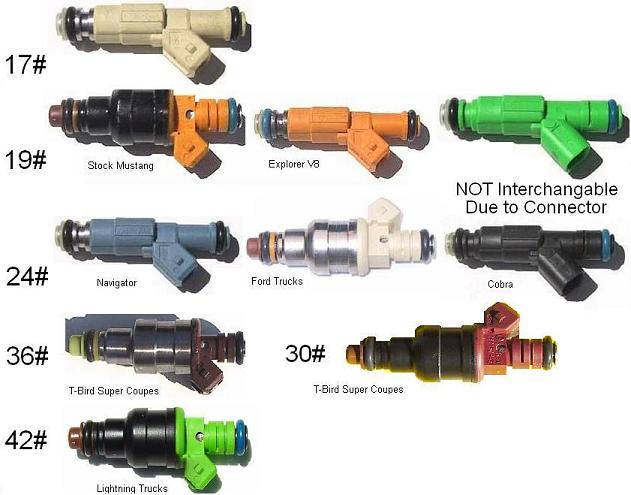Fox Fuel Injection overview
Let's list the basic components:
Computer/EEC/ECU: (A9L, A3M, A3M1, D3D1, X3Z, S0Z, A9M, A9P, C3W, C3W1, A9S, 8LD)
Applications aren't real important for this discussion and we'll be concerned with the A9L, A9P, and A9M for now.
EEC/Fuel Injection Harness:
Mass Air Meter: (these come in all shapes, sizes, and calibrations)
Fuel Injectors: (Sizes rage from 19lb/hr to 55lb/hr in low impedance form)
Low impedance injectors are generally what we use and are what our fuel injector systems are setup to use. Really High HP applications may require larger than 55lb/hr injectors. That's where the high impedance injectors come in. Additional hardware is required to run these injectors but it's not important to this discussion.
Our fuel injection system in OEM form uses an EEC, Mass air meter, Harness, and injectors to accomplish fuel metering and control delivery. The EEC is programmed to use Ford's Mass air meter, and 19lb/hr injectors to deliver the appropriate amount of fuel for the stock engine to make power all the way through it's usable rpm range. It juut so happens that 19lb/hr injectors are small enough to offer GREAT drivability and are also larger than what is required to support the HP from a stock 5.0 HO.
Elevated HP levels often require larger fuel injectors. There are a few ways this can be tackled.
The first is most popular and generally the least inexpensive:
Changing the mass air meter. A "calibrated" mass air meter fools the EEC into thinking it's running an OEM meter and stock injectors. These meters are calibrated to give the EEC a specific output signal to compensate for larger injectors by "lying" to the EEC so that it meters injector pulsewidth to meet power production demands of the motor. This typically works great for injectors up to 36lbs/hr. Injectors larger than that tend to differ too much in size for the OEM fuel ramps in the EEC to be efficient or work very well. 42 lb injectors and larger usually require modification to the EEC program in order to function efficiently.
The second method is a programmable ECU or EEC tuner:
These modify the actual EEC programming. Some give you the abilty to load the transfer curve for the mass air meter to the EEC then let you specify an injector size. Others allow you to simply add or subract fuel at given loads and RPM. This latter type (add/subtract) still requires a "calibrated" meter. Either way, this second method allows allot more control and tunability and allows you to tailor your fuel delivery to meet the demands of your modifications.
When a meter is said to be calibrated for X size injector, it's an oversimplified, general statement. The meter is not actually calibrated for a specific sized injector. The OEM meter is not calibrated for 19lb injectors (regardless of what many people think). Instead, the computer is programmed to meter the proper fuel for a given meter signal and specific sized injector. these "calibrated" meters are COMPUTER and INJECTOR SIZE specific, not just injector specific. Their signal putouts are modified so that the EEC's OEM programming coincides with the required injector pulsewidth. Injectors larger than 36s are often a problem because the EEC's lack of ability to trim differences in excess of a set tolerance. Imagine a computer that's programmed to open a 19 lb injector for .5 seconds for a postion stroke holding a 42 lb injector open for the same stroke. The more power you produce and the higher yougo into the RPM range, the wider the gap gets between the amount of fuel the EEC "thinks" it's putting out and the amount of fuel that's actually being sprayed into the cylinder. The minimum and maximum duration for a given injector also varies greatly. the larger the differences are in injector size over stock, the more trouble you'll have with trying to adjust without modifying the EEC.
I'm sure I've left something out.... If so, ask more questions. There's a few folks on this board that are awesome tuners and know this stuff backwards and front. Michael Yount, Hissin50, TMOSS, and JRichker, are a few. There are others that have more specific knowledge about particular EEC Tuners or Meters (because they run them).
Good Luck






